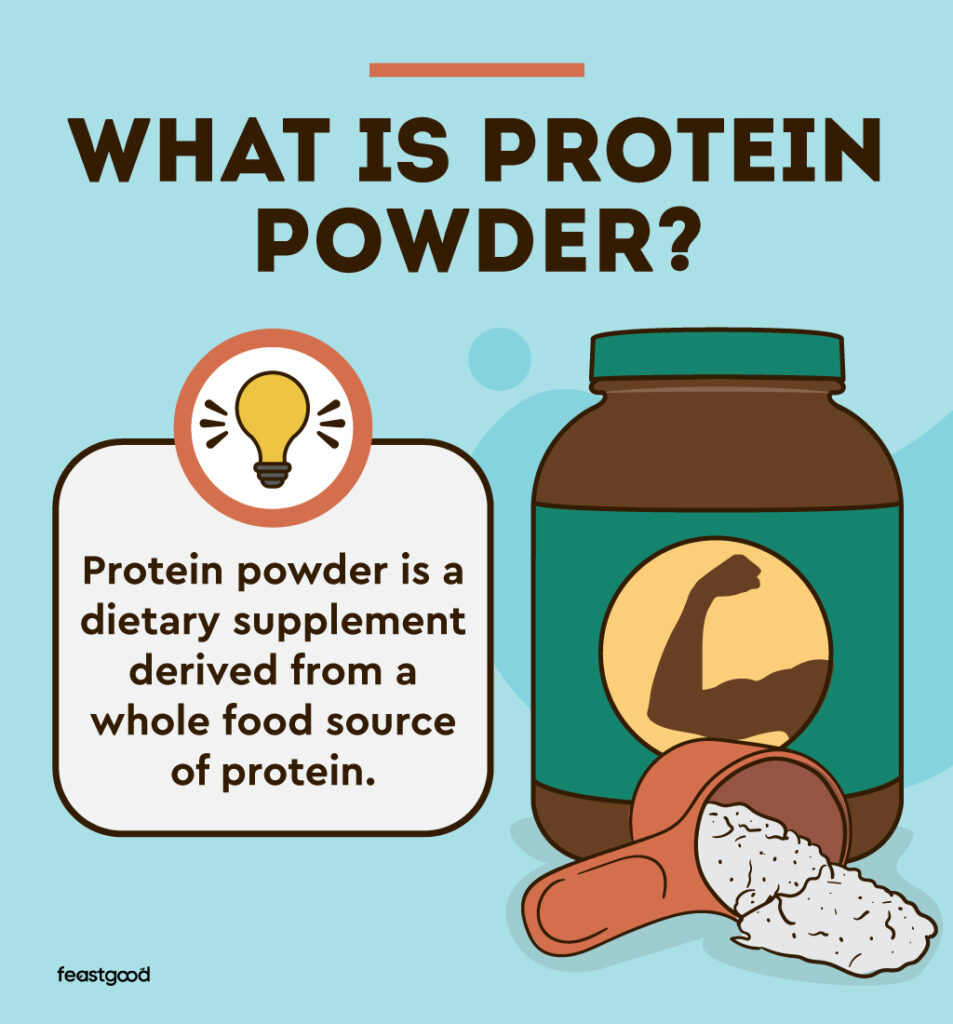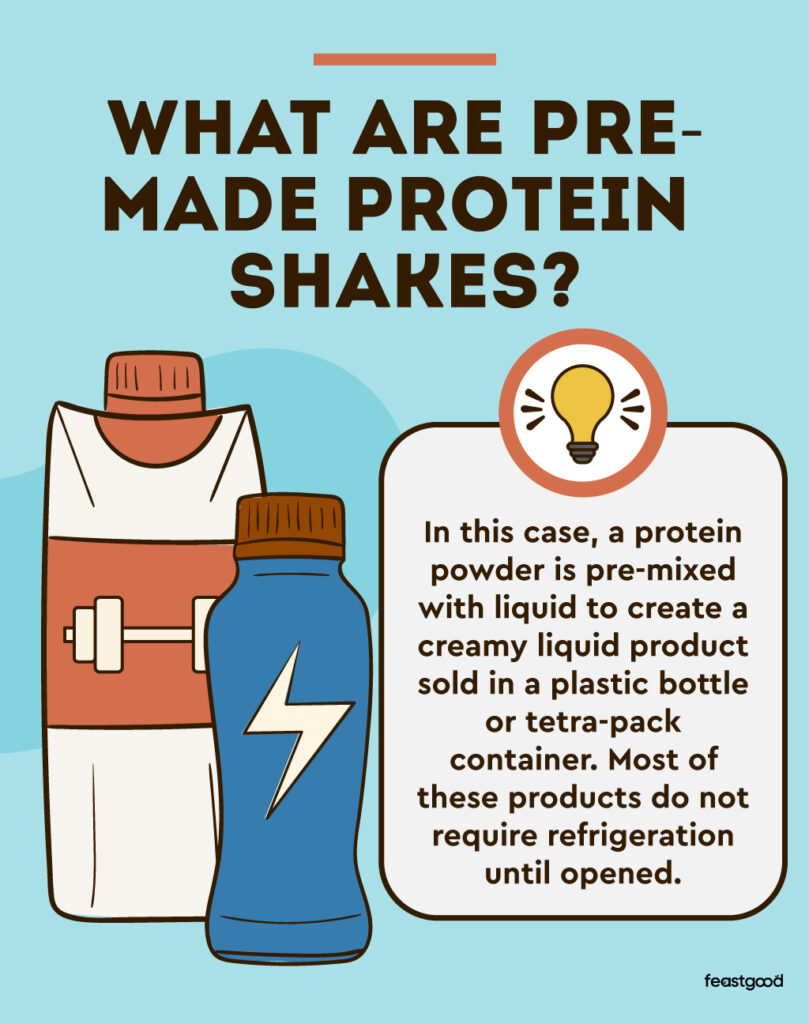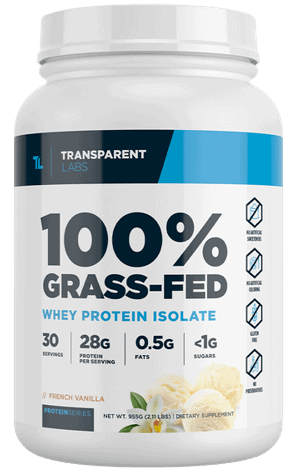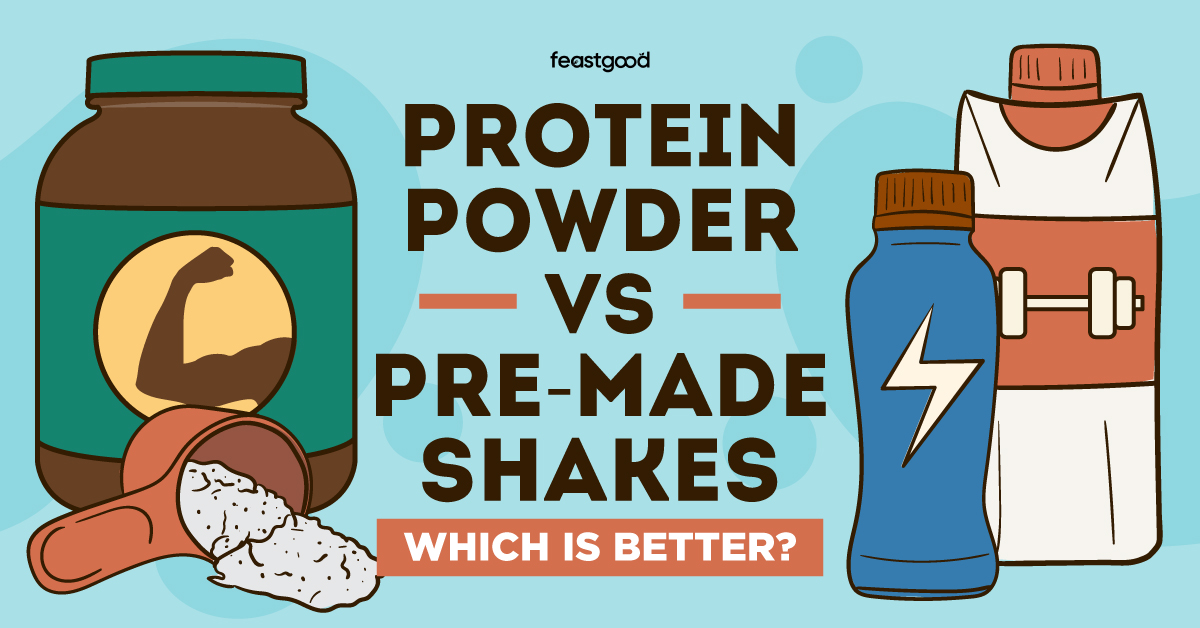Some links in this article are affiliate links, which means we earn from qualifying purchases. Learn more.
When you’re checking out protein supplements online or in-store, you might wonder whether you’re better off buying bottled pre-made shakes or mixing up your own shakes with protein powder. Below, I will compare the two, weigh the pros and cons, and give you my opinion as a multi-sport athlete and a certified nutrition coach.
Key Takeaways
- Both protein powder and protein shakes come in various options with different protein sources (plant-based versus animal-based), flavors, and amounts of protein and other macronutrients per serving.
- Ready-made protein shakes are more likely to contain added vitamins & minerals and are more convenient if you’re “on the go.” However, they are also more expensive and less versatile than protein powder.
- For most people, I’d recommend protein powder over pre-made shakes due to the lower cost, higher versatility, and longer shelf life. Pre-made shakes are only handy if you’re in a pinch for a quick meal replacement high in protein, but I wouldn’t rely on them daily.
At A Glance: Comparing Protein Powder & Pre-Made Shakes
| Category | Protein Powder | Pre-made Protein Shakes |
|---|---|---|
| Cost | $1.36 per serving | $2.10 per serving |
| Protein per serving | 21.5 grams per 30-gram serving | 24.4 grams per 11 fluid ounce serving |
| Vitamins & minerals | Not commonly added | Over half of the products reviewed had added vitamins & minerals |
| Additional supplements (e.g., creatine) | Not commonly added unless marketed as a mass-gainer or recovery product | Not commonly added |
| Versatility | Extremely versatile | Limited uses |
| Convenience | Requires access to a liquid and a shaker | Extremely convenient |
| Texture | Varies; can be thin or thick, lumpy or foamy | Fairly thin, smooth texture |
| Taste | Huge selection of flavors | Smaller selection of standard flavors (vanilla, chocolate, strawberry, and banana are most common) |
| Portability | Extremely portable | Heavier; liquid restrictions when traveling by air |
| Source | Wide-ranging | Usually whey or plant-based |
What Is Protein Powder?

Protein powder is a dietary supplement derived from a whole food source of protein.
There are different protein powder options based on dietary preferences and allergies.
For example, here are foods commonly processed into protein powders:
- Whey: whey protein powder comes from dairy milk separated into curds and whey. The liquid whey is processed into a fine powder that offers more protein.
- Beans or legumes: high-protein beans and legumes like soybeans or split peas are shelled, dried, and milled into plant-based protein powders. Various plant-based protein powders are often combined to create a complete protein, as most plant-based sources are not complete on their own, meaning they do not contain all nine essential amino acids that the body needs from food.
- Grains: as interest in plant-based diets continues to grow, more grains that are naturally high in protein (like oats, rice, and quinoa) are being processed into protein powders for use in a plant-based protein “matrix” along with legume-based powders (to make complete proteins).
- Egg whites: egg whites are dried and made into a fine powder for a dairy-free source of animal protein.
Less common options include insect-based protein powders (like cricket flour), beef protein powder, and powdered algae like spirulina or chlorella.
Protein powders are commonly sold in jars, bags, or tubs, ranging from single-serving packets of about 1 ounce to large pails weighing several pounds.
You can mix protein powder with water, juice, or other liquids to create protein shakes, blend it with additional ingredients to make protein smoothies, or cook with it.
- Related: Whey Protein vs Plant Protein – What Are The Differences?
What Are Pre-made Protein Shakes?

Pre-made (or ready-to-drink) protein shakes are also a dietary supplement.
In this case, a protein powder is pre-mixed with liquid to create a creamy liquid product sold in a plastic bottle or tetra-pack container. Most of these products do not require refrigeration until opened.
These protein shakes are ready to drink as-is. No additional liquid is required unless you want to use it as a base for a blended smoothie.
Ready-made protein shakes are more likely to contain added vitamins & minerals as part of the liquid suspension (a liquid mixture that doesn’t separate into thin liquid at the top and thick solids at the bottom).
Ready-made protein shakes use specific ingredients and processes to prevent them from separating, but it is still best to shake before consuming just in case the shake has gotten a bit thicker at the bottom.
I’ve also become a fan of freezing pre-made protein shakes as part of the base for protein ice cream in my Ninja Creami (I’m not in any way sponsored by Ninja – I just love the product and the high protein ice cream I can make).
10 Criteria for Protein Powder vs. Pre-made Protein Shakes
To help you decide between protein powder or pre-made protein shakes, I’ve compared them in the ten categories. The two products are very similar in some cases, and in other cases, there are dramatic differences to consider.

1. Cost
The most striking difference between protein powder and pre-made shakes is the cost per serving.
Pre-made shakes are more than one and a half times more expensive than protein powder for a standard serving (one 30-gram scoop for protein powder or one 11-fluid-ounce bottle for a pre-made shake).
The fact that a pre-made shake is ready to drink right away can make the higher price justifiable for people needing this convenience, as discussed below.
But if you’re on a budget, protein powder is more economical.
- Check out our article Cheapest Protein Powders (That Are Still High Quality).
The Winner: Protein Powder
2. Protein Per Serving
On average, pre-made protein shakes provide more protein per serving (24.4 grams in an 11-fluid-ounce bottle) than protein powder.
Out of 20 protein powders we reviewed, the average protein content was 21.5 grams in a 30-gram serving.
But total protein isn’t necessarily the most important way to evaluate the protein content of a food or supplement; instead, it’s important to consider protein per calorie.
For example, if a protein shake had 40 grams of protein per serving and 500 calories, it might be hard to hit your protein target without exceeding your recommended calorie intake for the day. This shake only provides 0.08 grams of protein per calorie.
On average, pre-made shakes have 0.1 grams of protein per calorie, and protein powder (on its own or mixed with water or another zero-calorie liquid) has 0.19 grams of protein per calorie, which means that you get nearly double the amount of protein per calorie when choosing a protein powder versus a pre-made protein shake.
Of course, this will change depending on what you mix the protein powder with (mixing it with juice or milk will add additional calories and macros), but it does give you more control over the macros in the final product.
The Winner: Protein Powder
3. Vitamins & Minerals
It’s common for pre-made protein shakes to advertise all of the added vitamins and minerals they contain.
These micronutrients may include fat-soluble vitamins A, E, and K, water-soluble B vitamins and vitamin C, and minerals such as phosphorus, magnesium, and zinc, among others.
Including these vitamins and minerals in a liquid suspension in a sealed bottle can be easier than a dry powder in a package that is routinely opened and closed, allowing air to react with the ingredients.
If you’re using your protein shake to supplement vitamins or minerals missing in your diet, then a pre-made shake can be a better choice.
On the other hand, if you’re eating a balanced diet with a range of minimally processed food choices, including fruits and vegetables, you likely don’t need these added micronutrients.
As always, discussing ANY dietary supplements (including protein shakes or protein powder) with your doctor or other health care professional is essential.
The Winner: Pre-made Shakes
4. Additional Supplements
Beyond vitamins and minerals, some people seek protein powders or shakes that include other common supplements like creatine.
For example, you can find protein powders with added creatine.
There are also protein powders marketed as a “recovery blend” that include additional supplements such as glutamine to promote muscle recovery.
I have not found any pre-made protein shakes with additional performance-boosting supplements such as creatine.
The Winner: Protein Powder
5. Versatility
Protein powder is incredibly versatile as it can be added to your diet in various ways to boost your protein intake.
Beyond making protein shakes and smoothies, you can bake and cook with protein powder or stir it into existing dishes.
Here are just a few ideas for adding protein powder to your food:
- Add protein powder to cereal
- Add protein powder to eggs
- Add protein powder to Greek yogurt
- Add protein powder to pancake mix
Pre-made protein shakes are sweetened, so they cannot be used in savory applications like an unflavored protein powder.
The Winner: Protein Powder
6. Convenience
Pre-made shakes are more convenient than protein powder because they are already mixed.
You don’t need to have a shaker bottle, cup, or blender; you don’t need to find a liquid source or bring one with you.
Additionally, they’re readily available at most stores and gas stations, making them the most convenient option when you’re on the go.
If you don’t have water or a shaker cup available, protein powder isn’t good for you unless you can find a food to stir it into, like the above examples.
You should never dry scoop protein powder because the consequences can be harmful due to the risk of choking on the powder.
The Winner: Pre-made Shakes
7. Texture
All the pre-made shakes I’ve tried have had a fairly thin, somewhat creamy texture, similar to partly skimmed milk (1-2%). They are not lumpy or foamy, making them more appealing to those who struggle with texture.
That said, with protein powder, you can cater to your textural preferences based on the protein powder you choose and how you mix it.
I prefer thicker protein shakes, almost with a milkshake texture, and I only get that if I mix up my smoothies in the blender with ice. Plus, sometimes I add extra ingredients like oats or frozen cauliflower for more volume and nutrients.
I could use a pre-made protein shake as the base for this kind of smoothie, but I don’t see the point if I get the same result using protein powder and the liquid of my choice (I prefer unsweetened almond milk).
Certain protein powders naturally have a thicker texture. Casein protein is the thickest, followed by whey concentrate and whey isolate. You can get protein powders that have blends of these different types of protein and/or also contain thickening agents like xanthan gum.
The Winner: Protein Powder
8. Taste
It used to be that pre-made shakes only came in “basic” flavors like chocolate, vanilla, strawberry, banana, and caramel.
But now, pre-made shakes are branching out to flavors like cookies & cream, pumpkin spice, chocolate peanut butter, cinnamon roll, coffee, and even root beer float.
Pre-made shakes seem to follow the same path that protein powders did: initially, protein powders were available in basic flavors like chocolate and vanilla, and now there are choices like Fruity Pebbles, Matcha Tea, and S’mores.
For now, there are still more flavors of protein powder available than flavors of pre-made shakes. But, the best-tasting option will still come down to personal preference.
The Winner: Tie
9. Portability
Protein powder is lighter and takes up less space than a pre-made shake.
You also don’t need to worry about restrictions on liquids if you travel with protein powder in carry-on luggage when taking a flight.
On the other hand, pre-made shakes mean you don’t need to worry about finding a shaker cup and/or liquid to mix.
The Winner: Protein Powder
10. Source
There are more plant-based pre-made protein shakes on the market now than there used to be (there are more pre-made shakes in general, as people look for convenient ways to add protein to their diet).
But, most pre-made protein shakes still rely on whey and/or milk protein.
Protein powders from many sources are available now, including (but not limited to) beef, egg, insect, plant, and dairy sources (including both casein and whey).
The Winner: Protein Powder
How To Pick Between Protein Powder vs. Pre-made Protein Shakes
Beyond the ten categories above, what else should you consider when choosing between pre-made shakes and protein powder?
When I talk to my clients or make choices for myself, I like to assess goals and lifestyle.
If Your Goal Is Weight Loss
If your goal is weight loss, I recommend protein powder because it has a higher protein-per-calorie ratio. Pre-made protein shakes come with at least some additional carbohydrates and fat, adding calories to the shake.
With protein powder, you are in control of the amount and type of additional ingredients, such as what you choose to mix with, allowing you to hit your calorie and macro targets easily.
If Your Goal Is Muscle Gain
If your goal is muscle gain, either protein powder or pre-made shakes would work.
Pre-made shakes have more calories per serving than protein powder.
But pre-made shakes don’t usually come with other performance-enhancing or recovery-focused ingredients that can help with the hard training needed for muscle gain.
You can also buy specialty protein powders that focus on “mass gaining” and have higher calories through added carbohydrates.
If You Have a Busy Lifestyle
If you have a busy lifestyle and know that you won’t take the time to measure out protein powder and mix it up, then it is worth paying for pre-made shakes to allow you to hit your protein target.
The added cost is the price you pay for saving time.
Protein Powder: Recommendations

My favorite protein powder is Transparent Labs 100% Grass-Fed Whey Protein Isolate Powder.
As a competitive athlete, it’s imperative to me that I can trust the labels on my supplements. Transparent Labs’ products are third-party certified to ensure the ingredients and their doses match the label.
Read our review to see why our team considers this the #1 brand.
Pre-made Protein Shakes: Recommendations
My favorite pre-made protein shake comes from Premier Protein (click to read our complete review).
When traveling to my in-laws’ vacation property, I know I won’t have access to a blender, so this is a great way to keep up my protein intake when I can’t make my favorite protein smoothies.
Plus, my in-laws like pouring some of the shakes into their coffee because they like the taste, and as a nutrition coach, I’m always encouraging them to bump up their protein intake as they get older.
Other Protein Comparisons
References
Baum, J., Kim, I.-Y., & Wolfe, R. (2016). Protein Consumption and the Elderly: What Is the Optimal Level of Intake? Nutrients, 8(6), 359. https://doi.org/10.3390/nu8060359
Agropur. (2023, October 4). How Whey Protein Is Made. Agropur. Retrieved from https://www.agropur.com/us/news/how-whey-protein-is-made
About The Author

Lauren Graham is a Precision Nutrition Level 1 certified nutrition coach. She focuses on helping busy professionals balance healthy eating and purposeful movement. Lauren has a background in competitive swimming and is currently competing as a CrossFit athlete. She has a passion for training, teaching, and writing.
Why Trust Our Content

On Staff at FeastGood.com, we have Registered Dietitians, coaches with PhDs in Human Nutrition, and internationally ranked athletes who contribute to our editorial process. This includes research, writing, editing, fact-checking, and product testing/reviews. At a bare minimum, all authors must be certified nutrition coaches by either the National Academy of Sports Medicine, International Sport Sciences Association, or Precision Nutrition. Learn more about our team here.
Have a Question?
If you have any questions or feedback about what you’ve read, you can reach out to us at [email protected]. We respond to every email within 1 business day.
